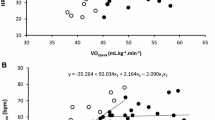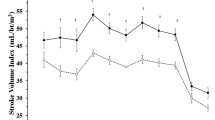Abstract
Gender differences in lung volumes and flow rates, and in respiratory control have been documented previously. How these gender differences affect exercise responses in normal subjects is less clear, particularly as many studies involved highly fit subjects. This study aimed to investigate potential gender differences occurring during progressive exercise in healthy males and females of average fitness. Fourteen males and ten females of mean (SD) age 23 (0.35) years completed a progressive exercise test to exhaustion on a cycle ergometer, with a ramp increase of 15 W min−1 (female) or 20 W min−1 (male). All females were studied during the follicular phase of their menstrual cycle. Cardiorespiratory variables were measured, breath by breath, and values were compared at rest, at 40 W, at physiologically equivalent workloads below, at and above the gas exchange threshold and at peak oxygen uptake (V̇O2peak). Mean V̇O2peak (SEM) was 32.4 (2.01) ml kg−1 min−1 for the females and 41.9 (1.80) ml kg−1 min−1 for the males. Females had a significantly lower end-tidal partial CO2 pressure at rest and throughout exercise. Increases in exercise minute ventilation were achieved by a significantly greater tidal volume in males, whereas females adopted a significantly greater breathing frequency. Ratings of respiratory discomfort were significantly greater in the male group at physiologically equivalent workloads compared to the female group. This study shows gender differences exist in the ventilatory and sensory response to progressive exercise in untrained subjects. Further work is required to ascertain if these effects are altered during the luteal phase of the menstrual cycle.




Similar content being viewed by others
References
Aitken ML, Franklin JL, Pierson DJ, Schoene RB (1986) Influence of body size and gender on control of ventilation. J Appl Physiol 60:1894–1899
Becklake MR, Kauffmann F (1999) Gender differences in airway behaviour over the human life span. Thorax 54:1119–1138
Beidleman BA., Rock PB, Muza SR, Fulco CS, Forte VA Jr, Cymerman A (1999) Exercise V E and physical performance at altitude are not affected by menstrual cycle phase. J Appl Physiol 86:1519–1526
Blackie SP, Fairbarn MS, McElvaney NG, Wilcox PG, Morrison NJ, Pardy RL (1991) Normal values and ranges for ventilation and breathing pattern at maximal exercise. Chest 100:136–142
Dempsey JA., Hanson PG, Henderson KS (1984) Exercise-induced arterial hypoxaemia in healthy human subjects at sea level. J Physiol (Lond) 355:161–175
Goldstein SA, Weissman C, Askanazi J, Rothkopf M, Milic-Emili J, Kinney JM (1987) Metabolic and ventilatory responses during very low level exercise. Clin Sci (Colch) 73:417–424
Gore CJ, Little SC, Hahn AG, Scroop GC, Norton KI, Bourdon PC, Woolford SM, Buckley JD, Stanef T, Campbell DP, Watson DB, Emonson DL (1997) Reduced performance of male and female athletes at 580 m altitude. Eur J Appl Physiol 75:136–143
Harms CA, McClaran SR, Pegelow DF, Nickele GA, Dempsey JA (1998) Exercise induced arterial hypoxaemia in healthy young women. J Physiol (Lond) 507:619–628
Harms CA, Wetter TJ, Dempsey JA (1999) Breathing in exercise. In: Cherniak N, Altose MD, Homma I (eds) Rehabilitation of the patient with respiratory disease. McGraw-Hill, New York, pp 87–96
Horton TJ, Pagliassotti MJ, Hobbs K, Hill JO (1998) Fuel metabolism in men and women during and after long duration exercise. J Appl Physiol 85:1823–1832
Lebrun CM, McKenzie DC, Prior JC, Taunton JE (1995) Effects of menstrual cycle phase on athletic performance. Med Sci Sports Exerc 27:437–444
Loiseau A, Dubreuil C, Pujet JC (1990) A visual analogue scale of exercise dyspnea. Rev Mal Respir 7:39–44
McClaran SR, Harms CA, Pegelow DF, Dempsey JA (1998) Smaller lungs in women affect exercise hyperpnea. J Appl Physiol 84:1872–1881
Mead J (1980) Dysanapsis in normal lungs assessed by the relationship between maximal flow, static recoil and vital capacity. Am Rev Respir Dis 121:339–342
Patterson DJ, Pinnington H, Pearce AR, Morton AR (1987) Maximal exercise cardiorespiratory responses of men and women during acute exposure to hypoxia. Aviat Space Environ Med 58:243–247
Regensteiner JG, Pickett CK, McCullough RE, Weil JV, Grindlay Moore L (1988) Possible gender differences in the effect of exercise on hypoxic ventilatory response. Respiration 53:158–165
Robergs RA, Roberts SO (eds) (2000) Gender and exercise performance. In: Fundamental principles of exercise physiology for fitness, performance and health. McGraw-Hill, New York, pp 410–422
Schoene RB, Robertson HT, Pierson DJ, Peterson AP (1981) Respiratory drives and exercise in menstrual cycles of athletic and nonathletic women. J Appl Physiol 50:1300–1305
Sebert P, Barthelemy L, Mialon P (1990) CO2 chemoreflex drive of ventilation in man: effects of hyperoxia and sex differences. Respiration 57:264–267
Shephard RJ (2000) Exercise and training in women. Part I: influence of gender on exercise and training responses. Can J Appl Physiol 25:19–34
Sue DY, Wasserman K, Moricca RB, Casaburi R (1988) Metabolic acidosis during exercise in patients with chronic obstructive pulmonary disease. Use of the V-slope method for anaerobic threshold determination. Chest 94:931–8
Takano N, Inaishi S, Zhang Y (1997) Individual differences in breathlessness during exercise, as related to ventilatory chemosensitivities in humans. J Physiol (Lond) 499:843–848
Tatsumi K, Hannhart B, Moore LG (1995) Influences of sex steroids on ventilation and ventilatory control. In: Dempsey JA, Pack AI (eds) Regulation of breathing, 2nd edn, vol 79. Dekker, New York, pp 829–864
Thurlbeck WM (1982) Postnatal human lung growth. Thorax 37:564–571
Weissman C, Abraham B, Askanazi J, Milic-Emili J, Hyman AI, Kinney JM (1982) Effect of posture on the ventilatory response to CO2. J Appl Physiol 53:761–765
White DP, Douglas NJ, Pickett CK, Weil JV, Zwillich CW (1983) Sexual influence on the control of breathing. J Appl Physiol 54:874–879
Williams TJ, Krahenbuhl GS (1997) Menstrual cycle phase and running economy. Med Sci Sports Exerc 29:1609–1618
Wilson RC, Jones PW (1989) A comparison of the visual analogue scale and modified Borg scale for the measurement of dyspnoea during exercise. Clin Sci (Colch) 76:277–282
Acknowledgements
This study was supported by a University College Presidential scholarship and Enterprise Ireland. All experiments undertaken comply with the Ethical Committee guidelines of St Vincent's University Hospital, Ireland.
Author information
Authors and Affiliations
Corresponding author
Rights and permissions
About this article
Cite this article
Kilbride, E., McLoughlin, P., Gallagher, C.G. et al. Do gender differences exist in the ventilatory response to progressive exercise in males and females of average fitness?. Eur J Appl Physiol 89, 595–602 (2003). https://doi.org/10.1007/s00421-003-0853-z
Accepted:
Published:
Issue Date:
DOI: https://doi.org/10.1007/s00421-003-0853-z




